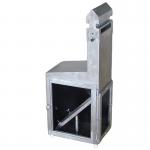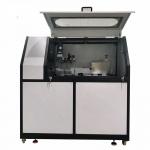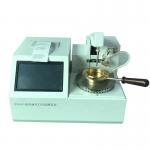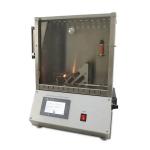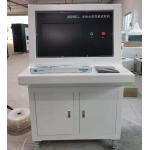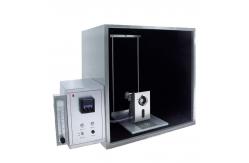In the realm of interior design and fire safety, curtains and
drapes play a significant role. The BS 5867 Flammability Testing
Equipment for Curtains and Drapes is a specialized apparatus that
is essential for evaluating the fire performance of these
fabric-based window coverings. The BS 5867 Flammability Testing Equipment is designed to conduct
flammability tests on curtains and drapes in accordance with the BS
5867 standard. It is a crucial tool in textile manufacturing
facilities, quality control laboratories, and regulatory inspection
bodies. By subjecting curtain and drape samples to specific
ignition sources and measuring parameters such as flame spread,
afterflame time, and char length, it determines the level of fire
resistance or flammability of these products. This information is
vital for ensuring that curtains and drapes used in various
settings, from residential to commercial and public spaces, meet
the necessary safety requirements and do not pose an undue fire
hazard. - Robust and Controlled Testing Chamber
- The testing chamber is constructed from high-quality heat-resistant
materials, typically stainless steel. It is designed to have a
well-defined and enclosed space to ensure accurate and reproducible
testing conditions. The interior of the chamber is smooth and
non-combustible to prevent any interference with the test results.
It is equipped with a ventilation system that can be precisely
controlled to manage the air flow and oxygen supply during the
test, simulating different environmental conditions.
- The sample holder within the chamber is adjustable and can securely
hold curtains and drapes of various sizes and weights. It is
designed to present the sample in a vertical or horizontal
position, depending on the specific test requirements of the BS
5867 standard. The holder is made from materials that can withstand
the high temperatures and forces generated during the test.
- Precision Ignition and Measurement Systems
- The equipment is equipped with a reliable ignition source. This
could be a gas burner or an electric ignition device that is
calibrated to produce a consistent and controlled flame. The flame
height, temperature, and exposure time can be accurately adjusted
to match the parameters specified in the BS 5867 standard. For
example, the flame height might be set to a specific millimeter
measurement, and the exposure time could be precisely timed using
an advanced timer.
- The measurement system includes sensors to detect and record
various aspects of the test. It can measure the time the sample
burns after the ignition source is removed (afterflame time), the
length of the charred area on the sample (char length), and the
rate at which the flame spreads across the fabric. The data
acquisition system records all these parameters in real-time and
can generate detailed reports, complete with graphs and charts,
that provide a comprehensive analysis of the flammability
characteristics of the curtain or drape sample.
- Safety Features and Compliance
- The BS 5867 Flammability Testing Equipment is equipped with
multiple safety features. It has a safety shut-off mechanism for
the ignition source and gas supply in case of any abnormal
combustion or emergency. The chamber is designed to contain any
potential flying debris or embers in case the curtain or drape
sample ignites and breaks apart. The equipment also complies with
all relevant safety and regulatory standards, ensuring the safety
of the operator and the surrounding environment during the testing
process.
| Overall Specifications | Dimensions: W675 x D500 x H700mm | | Structure | 12mm thick Marinite mineral plate (calcium silicate board),
externally wrapped with 1.2 thick 304# stainless steel. Front is an
open test box with inner surface painted with smooth black paint. | | Compliance (NFPA) | NFPA 701:2004 Chapter 5 Requirements | | Burner | Hammer-shaped laboratory burner for Meker Burner with heat of
10,500 BUT/Hour. Meets requirements of 5.3.3 of NFPA NF: 701:2004. | | Needle for sample installation | 9mm stainless steel strip, 190mm long, with a diameter of 0.7mm,
11mm long steel needle | | Wire Brush | Meets 5.9 Requirements for Bronze Manufacture (NFPA) NFPA 701:2004 | | Sample holder | Equipped with 5 stainless steel sample holders and 5 stainless
steel standard sample holders. Also equipped with 1 volume of
standard combustion line. | | Control Section | Compliance with (NFPA) NFPA 701:2004 5.6 Requirements | | Control part (within Control Section) | Adopt automatic mode: such as trigger timing, automatic opening and
cutting off air source. | | Touching method (within Control Section) | Adopting the proximity switch, that is, triggering the timing
start. | | Gas supply system (within Control Section) | Equipped with a pressure reducing valve. The solenoid valve is used
to perform automatic opening and shutting off the air supply.
Compliance with (NFPA) NFPA 701:2004 5.4 requirements | | Timer (within Control Section) | 0~99.99 seconds can be set arbitrarily, resolution: 0.01 seconds,
accuracy: 0.1 seconds. | | Flowmeter (within Control Section) | Rotameter, used to adjust the degree of flame. |
- Accurate Flammability Evaluation
- The primary function of the BS 5867 Flammability Testing Equipment
is to provide a detailed and accurate assessment of the
flammability of curtains and drapes. By precisely measuring the
flame spread rate, afterflame time, and char length, it determines
the potential fire risk associated with these window coverings.
This information is valuable for manufacturers to improve their
product designs and select more fire-resistant materials. For
instance, a manufacturer can use the test results to develop a new
line of curtains with enhanced fire safety features, such as using
flame-retardant fabrics or adding fire-resistant coatings.
- The measurement of these parameters also helps in understanding the
combustion behavior of different curtain and drape fabrics. It can
identify whether a fabric has a tendency to melt, drip, or produce
excessive smoke during combustion, which are all important factors
in assessing its overall fire hazard.
- Compliance with Safety Standards and Regulations
- The textile and interior design industries are subject to strict
safety standards and regulations. The BS 5867 tester is a reliable
tool for ensuring compliance. It enables manufacturers to conduct
tests in accordance with the BS 5867 standard and other relevant
international and national safety regulations. By using this
equipment, manufacturers can prove that their curtains and drapes
meet the necessary flammability criteria, facilitating market
access and enhancing consumer confidence.
- Regulatory bodies rely on the accurate test results obtained from
this equipment to enforce safety regulations. It serves as a
dependable means for inspectors and certifying agencies to
determine the suitability of curtains and drapes for use in
different environments and applications. Only those that pass the
flammability test and meet other safety requirements are approved
for sale and use.
- Research and Development Support
- In the field of textile research and development, the testing
equipment is an invaluable asset. It allows textile scientists and
engineers to study the effects of different fiber compositions,
fabric weaves, and finishing treatments on the flammability of
curtains and drapes. For example, in the development of new
flame-retardant curtain fabrics, the equipment can be used to
evaluate the effectiveness of different flame-retardant additives
and their impact on the overall performance of the fabric.
- By understanding how various factors influence the flammability of
curtains and drapes, researchers can optimize the design and
production of fire-safe window coverings. This could involve the
selection of more suitable fibers, the improvement of fabric
construction techniques, or the development of new and more
effective flame-retardant technologies. The detailed data provided
by the BS 5867 testing equipment serves as a roadmap for driving
innovation and improving the overall fire safety of curtains and
drapes.
- Stringent Manufacturing Process
- The BS 5867 Flammability Testing Equipment is manufactured under
strict quality control procedures. Each component is carefully
sourced and inspected for quality and performance. The assembly
process is carried out by highly trained technicians in a clean and
controlled environment, ensuring the proper alignment and
functionality of all parts.
- The calibration of the ignition source, sensors, and measurement
systems is a critical and regular part of the manufacturing
process. It is performed using traceable reference standards to
guarantee the accuracy and reproducibility of the test results.
Rigorous quality audits and inspections are conducted at various
stages of production to maintain the highest level of product
quality.
- Quality Certification and Validation
Our testing equipment has obtained relevant quality certifications
and has been validated by independent testing laboratories. It has
been proven to provide accurate and reliable test results,
conforming to the BS 5867 standard and other relevant safety and
performance standards. We also continuously update and improve our
product based on the latest technological advancements and customer
feedback to ensure its long-term performance and compliance.
- Textile and Curtain Manufacturing
- A leading curtain manufacturer used the BS 5867 tester to develop a
new line of fire-resistant curtains. The test results showed that
the new curtains had a significantly reduced flame spread rate and
afterflame time compared to their previous models. This enabled
them to market the curtains as a premium fire-safe option, meeting
the increasing demand for fire-safe window coverings in hotels,
theaters, and public buildings. The company experienced an increase
in sales and enhanced its reputation in the market.
- A textile producer focused on interior fabrics utilized the
equipment to optimize the performance of their drape fabrics. By
testing different fiber blends and finishing treatments, they were
able to improve the fire resistance of their products, reducing the
risk of fire-related incidents in residential and commercial
interiors.
- Research Institutions
- A research institute dedicated to textile technology used the BS
5867 Flammability Testing Equipment to study the long-term
durability of flame-retardant finishes on curtains. The data
obtained helped them develop new and more durable flame-retardant
coatings that could withstand repeated washing and sunlight
exposure, contributing to the advancement of textile finishing
technology and the improvement of fire safety in window coverings.
- Another research institution investigated the effect of
nanotechnology on the flammability of curtain fabrics. Their
studies led to the discovery of new nanoparticle-based
flame-retardant additives that could enhance the fire resistance of
fabrics without sacrificing their aesthetic and functional
properties, opening up new avenues for the development of
high-performance fire-safe curtains.
- Regulatory and Inspection Agencies
|
